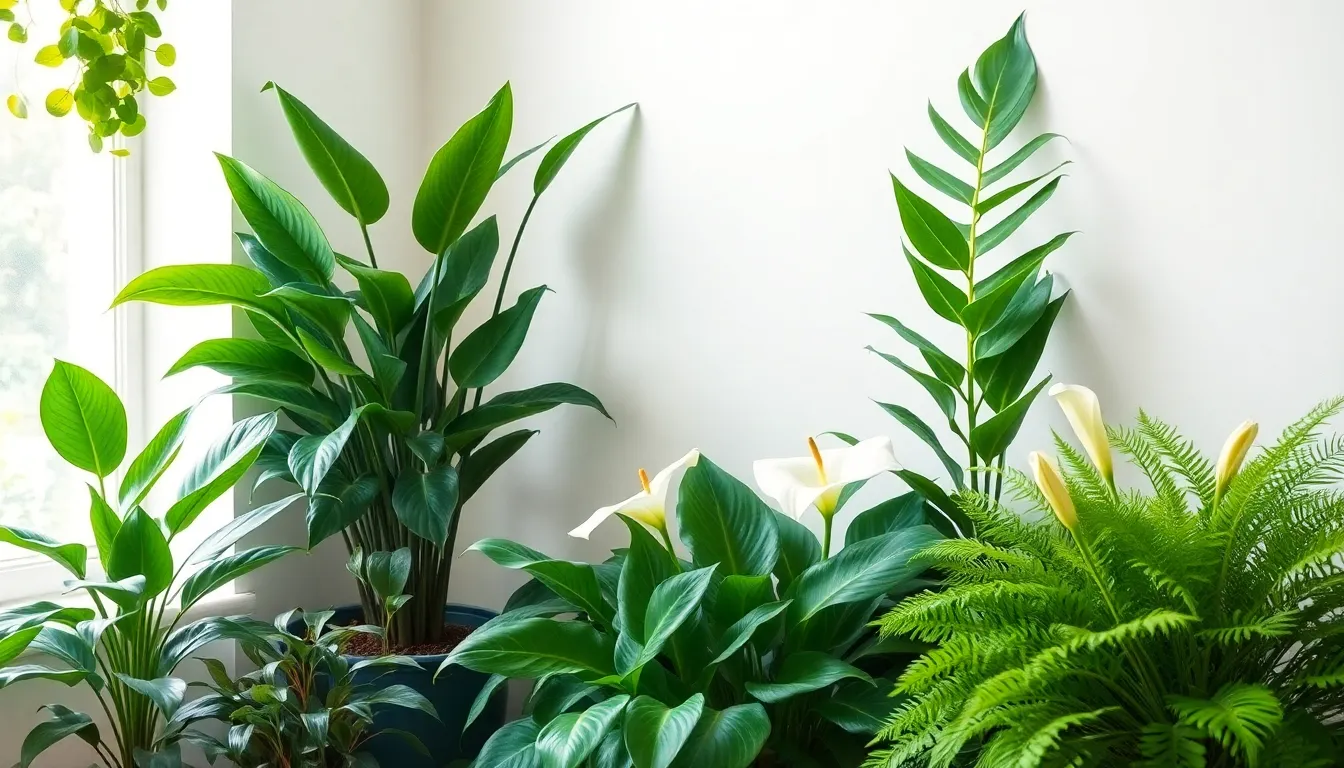Table of Contents
ToggleNot everyone has a sun-drenched living room or a green thumb that can coax life from the most stubborn of plants. For those who find themselves in a dimly lit corner of the house, fear not! There are plenty of houseplants that thrive in low light, proving that even the shadiest spots can be transformed into a lush oasis.
Imagine a plant that doesn’t demand daily sunbathing sessions or constant attention. These leafy companions are not just survivors; they’re the true champions of indoor gardening. From the resilient snake plant to the charming pothos, these green wonders will not only brighten your space but also elevate your mood. So, let’s dive into the world of low-light houseplants that can thrive even in the darkest of corners, turning your home into a botanical retreat.
Overview of Low Light Conditions
Low light conditions pose specific challenges for indoor gardening. Many homes lack direct sunlight, which can limit the number of plants that thrive. Even with dim lighting, numerous houseplants adapt well and flourish. Characteristics such as adaptability and resilience define these plants, allowing them to withstand less-than-ideal illumination.
Plants in low light settings often develop unique survival strategies. They may possess larger leaves to capture more light or have slower growth rates, balancing energy consumption and growth efficiency. Understanding these adaptations helps in selecting the right species for low-light environments.
Interior spaces provide varying levels of light, classifying them into distinct categories. Low light generally refers to areas receiving less than three hours of sunlight, often found in corners or north-facing rooms. Choosing plants that fit these conditions enhances the visual appeal and mood of a home.
Certain houseplants excel in these lower light conditions. For example, snake plants thrive with minimal light, producing fresh air and greenery. Pothos plants also adjust well, bringing vibrant colors to shaded areas. Identifying these resilient options simplifies the decision-making process and ensures successful indoor gardening.
Creating an inviting atmosphere relies heavily on selecting the right plants for low-light conditions. The visual and emotional benefits of adding greenery to these areas play a significant role in enhancing living spaces. Prioritizing the needs of specific plants contributes to their success and overall aesthetic appeal.
Types of Low Light House Plants

Several plants thrive in low-light conditions, proving ideal for indoor gardening. These varieties flourish in spaces with limited sunlight, allowing homeowners to enjoy greenery without bright light.
Popular Varieties
Snake plants represent one of the most resilient options. Pothos showcases heart-shaped leaves and long trailing vines, bringing life to any corner. ZZ plants tolerate neglect and thrive on minimal light. Peace lilies add elegance with their white blooms, even in dimly lit areas. Ferns, such as the Boston fern, provide lush foliage and adapt well to shade. Each of these plants serves as a fantastic choice for low-light environments.
Unique Features
Snake plants feature thick, upright leaves, allowing them to store moisture. Pothos grow rapidly and can climb or trail, proving versatile for various spaces. ZZ plants possess glossy, dark green leaves that reflect light beautifully. Peace lilies bloom sporadically, producing stunning white flowers and improving air quality. Ferns often demonstrate feathery fronds, adding texture and softness to the decor. These unique characteristics make low-light plants appealing for indoor settings.
Benefits of Low Light Plants
Low light plants provide several advantages for indoor environments. Their resilience contributes to a healthier living space.
Air Quality Improvement
Air quality improvement ranks among the key benefits of low light plants. These plants absorb toxins like formaldehyde and benzene from indoor air. NASA’s Clean Air Study identified several plants that excel in purifying air, including snake plants and peace lilies. Increased humidity levels result from transpiration, a process where plants release moisture into the air, promoting healthier breathing. They also help reduce airborne pollutants, enhancing overall indoor air quality.
Aesthetic Appeal
Aesthetic appeal is another significant benefit of low light plants. These plants add a touch of greenery to otherwise dull spaces. Their diverse colors and shapes create visual interest throughout interiors. Choosing plants like pothos and ZZ plants helps to liven up corners and shelves. Designing with low light plants enables homeowners to create a soothing atmosphere. Their presence can uplift mood and invite tranquility into any room.
Care Tips for Low Light Plants
Caring for low light houseplants requires specific attention to their unique needs. Proper watering, ideal soil, and occasional fertilization contribute significantly to their health.
Watering Guidelines
Underwatering is a common issue with low light plants, so it’s essential to check the soil moisture regularly. Allow the top inch of soil to dry out between waterings, preventing over-saturation. Snake plants thrive on minimal moisture, while pothos prefer slightly more; adjust watering frequency accordingly. Water less in winter, as most plants enter a dormant stage. Observing the plant’s leaves can provide helpful clues; yellowing often indicates overwatering, while wilting leaves suggest underwatering.
Ideal Soil and Fertilization
Selecting the right soil enhances plant growth in low light conditions. Use a well-draining potting mix, formulated to retain some moisture while allowing excess water to escape. Adding perlite or cactus soil can improve drainage for plants like ZZ and pothos. Fertilizing also plays a role in plant health; during the growing season, apply a diluted, balanced fertilizer once a month. Over-fertilization can harm or burn roots, so err on the side of caution.
Low-light houseplants offer a fantastic solution for those struggling to bring greenery into dim spaces. By selecting resilient plants like snake plants and pothos, anyone can effortlessly enhance their home’s atmosphere. These plants not only beautify but also contribute to improved air quality and a calming environment.
With the right care and attention, low-light plants can thrive and transform any indoor area into a vibrant retreat. Embracing these hardy beauties will create a welcoming space that uplifts mood and invites tranquility. So why not start your indoor garden today and enjoy the benefits of low-light houseplants?




